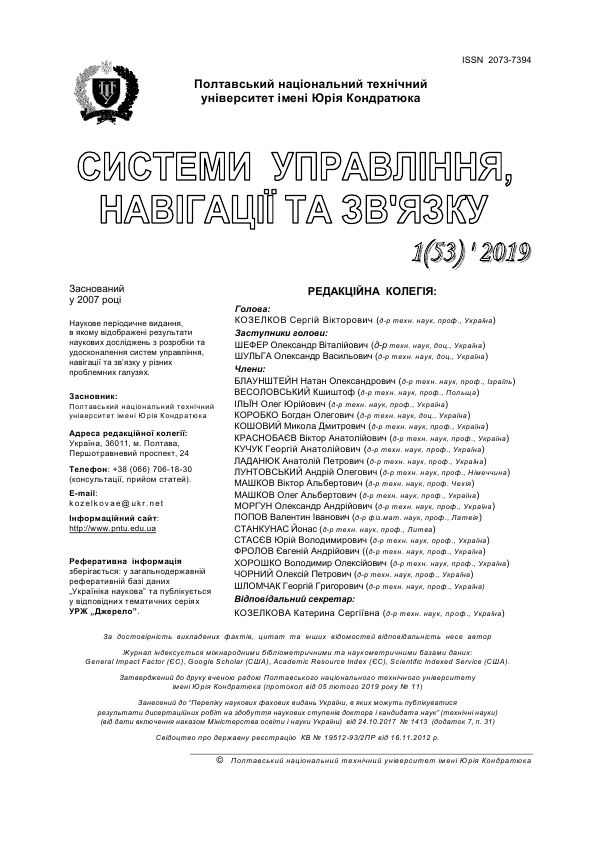OPTIMIZATION OF THE PROCESS OF CHOOSING THE LOCATION OF SOLAR POWER STATIONS USING GIS ANALYSIS
DOI:
https://doi.org/10.26906/SUNZ.2019.1.017Keywords:
solar power plant, solar potential, factors, inaccuracies matrix with errors, decisive rulesAbstract
In this paper, the main principles for optimizing the process of choosing the location of solar power plants are presented, due to an integrated approach to the selection of criteria for geospatial analysis of the territories. All the key indicators that influence the choice are analyzed. The mathematical calculations of the values of the necessary input factors for optimization of the process of choosing the location of the solar power plant are carried out. The division of the territory of Ukraine into the basic zones of solar potential is substantiated. Forms of inaccuracies matrix with errors between reference and input values. Selected the factor of greatest influence on the optimal choice of location of solar panels according to the inverted Floyd-Worcesh algorithm. The method of forming the decisive rules for choosing a location based on the compliance of statistical indicators with the value of the constructed scale of conformity of qualitative estimates of the belonging of each factor to one of the three groups belonging to the allocated zones is given. The method of optimal choice of location for solar power plants is presented. The mathematical algorithm for choosing the optimal area for the construction of solar power plants (SES) is considered and the adequacy of the presented method by the comparative analysis with real data is checked. The expediency of the use of geoinformation technologies and GIS analysis methods in the construction of cartographic models with the joint use of space monitoring data and statistical data is shown.Downloads
References
Солнечная энергетика: учеб.пособие для вузов / В. И. Виссарионов, Г. В, Дерюгина, В. А. Кузнецов, Н.К. Малинин; под ред. В.И. Виссарионова. – 2-е изд., стер. – М.: Издательский дом МЭИ, 2011. – 276 с
Кондратьев К. Я. Радиационный режим наклонных поверхностей / К. Я. Кондратьев, З. И. Пивоварова, М. П. Федоров. – М.: Гидрометеоиздат, 1978. – 220 с.
Карты распределения солнечного потенциала — [Електроний ресурс]: https://rentechno.ua/blog/solar-electricity-potential-maps.html (дата обращения — 15.01.2018).
Нунумете Р.А. Прогноз потенциала солнечного излучения территории острова Амбон (Индонезия) // Альтернативная энергетика и экология. – 2014. – Н. 154. - № 14. – С. 52-57.
Ориентация и угол наклона солнечных коллекторов – [Електроний ресурс]: http://solarsoul.net/orientaciya-i-ugol-naklona-solnechnyx-kollektorov (дата обращения — 11.02.2018).
Map of solar radiation in Europe: Ukraine / М. Suri, T. Cebecauer, T. Huld, E. D. Dunlop // Materials of JRC European commission. — PVGIS: European communities, 2001—2008. — p. 27.
Математика и САПР. Кн. 2 Вычислительные методы. Геометрические методы. – М.: Мир, 1989. – 260 с.
Ярымбаш Д. С. Особенности идентификации интенсивности солнечной радиации при проектировании солнечных электростанций / Д. С. Ярымбаш, Ю. В. Даус // Электроэнергетика и электротехника. – 2014. – № 1. – с 74-78.
Солнечная электростанция: прибыльный бизнес или недешевая игрушка? / Матеріали компанії Rentechno [Електронний ресурс]. — Режим доступу: http://rentechno.ua/articles/solnechnaya-energetika-pribilniy-biznes.html.
V. Manikandan, V. Porkodi, Amin Salih Mohammed and M. Sivaram (2018), “Privacy preserving data mining using threshold based fuzzy cmeans clustering”, ICTACT Journal On Soft Computing, 2018, Vol. 09, Issue 01, pp. 1813-1816.
Коваленко А.А. Использование временных шкал при аппроксимации длины очередей компьютерных сетей / А.А. Коваленко, Г.А. Кучук, И.В. Рубан // Сучасний стан наукових досліджень та технологій в промисловості. – 2018. – № 2 (4). – С. 12–18. – DOI: http://doi.org/10.30837/2522-9818.2018.4.012
Фаренбрух А. Солнечные элементы: теория и эксперимент : [Пер. с англ. И. П. Гавриловой и А. С. Даревского; под ред. М. М. Колтуна] / А. Фаренбрух, Р. Бьюб. — М. : Энергоатомиздат, 1987. — 280 с. –ил.
Штейнберг А.Я. Расчет инсоляции зданий. - Киев, Будивельник, 1975. - 120 с.
Герасименко Е.П., Зозулевич Д.М. Методы формирования трехмерных рецепторных матриц на ЭВМ. // В кн.: Вычислительная техника в машиностроении. – Минск. ИТК АН БССР, 1971. – с. 24 – 31.
Твайдел Дж. Возобновляемые источники энергии / Дж. Твайдел, А. Уэйр. М.: Энергоатомиздат, 1990. – 386 с.
Новые Энергетические Технологии [Электронный ресурс] – 2014. – http://iknet.com.ua/presentation/full/energetika.
Скулачев В.П. Эволюция биологических механизмов запасания энергии // Тамже. 1997. № 5. С. 11-19.
Мэрфи Л. M. Перспективы развития и финансирование технологий использования возобновляемых источников энергии в США // Труды Междунар. конгресса «Бизнес и инвестиции в области возобновляемых источников энергии в России», Москва, 31.05—4.06. 1999. M.: НИЦ «Инженер»,1999. C. 59-67.
Солнечное излучение в Украине – [Електроний ресурс]: http://solarsoul.net/intensity-of-solar-radiation-2.
Электротехнические проблемы создания преобразовательных установок для солнечных и ветровых электростанций / Бородулин М. Ю., Кадомский Д.Е. // Электрические станции. –1997. — № 3. – c.53-57.
Butenko O. S., Zamirets, O. O., The determination of degrees of combinatorial influence of the natural phenomena occurrence’s factors [Text] / O. O. Zamirets, O. S. Butenko – Nauka i Studia, Przemysl, Poland. – 2015 – 5 (136) – pp. 81 - 87




